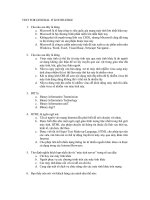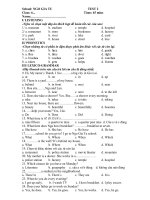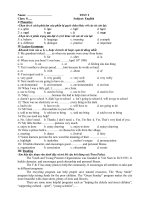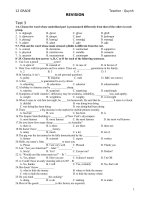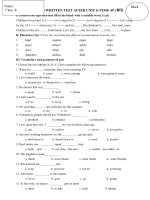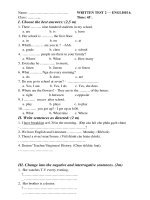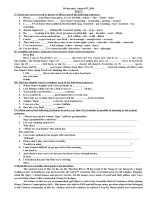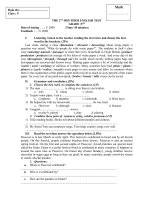General chemistry test (2)
Bạn đang xem bản rút gọn của tài liệu. Xem và tải ngay bản đầy đủ của tài liệu tại đây (386.64 KB, 16 trang )
MCAT Subject Tests
Dear Future Doctor,
The following Subject Test and explanations contains questions not in test format and
should be used to practice and to assess your mastery of the foundation content
necessary for success on the MCAT. Simply memorizing facts is not sufficient to achieve
high scores; however, an incomplete understanding of basic science knowledge will limit
your ability to think critically. Think of building your content knowledge as learning the
vocabulary and practicing MCAT-like questions as actually speaking.
All rights are reserved pursuant to the copyright laws and the contract clause in your
enrollment agreement and as printed below. Misdemeanor and felony infractions can
severely limit your ability to be accepted to a medical program and a conviction can
result in the removal of a medical license. We offer this material for your practice in your
own home as a courtesy and privilege. Practice today so that you can perform on test
day; this material was designed to give you every advantage on the MCAT and we wish
you the best of luck in your preparation.
Sincerely,
Albert Chen
Executive Director, Pre-Health Research and Development
Kaplan Test Prep
© 2003 Kaplan, Inc.
All rights reserved. No part of this book may be reproduced in any form, by Photostat, microfilm,
xerography or any other means, or incorporated into any information retrieval system, electronic
or mechanical without the written permission of Kaplan, Inc. This book may not be duplicated,
distributed or resold, pursuant to the terms of your Kaplan Enrollment Agreement.
_________________________________________________________
GENERAL CHEMISTRY SUBJECT TEST 2
General Chemistry Subject Test 2
1.
Which one of the following reactions will be
accompanied by an increase in entropy?
5.
A. Na(s) + H2O(l) ∅ NaOH(aq) + H2(g)
B. I2(g) ∅ I2(s)
C. H2SO4(aq) + Ba(OH)2(aq) ∅ BaSO4(s) +
H2O(l)
D. H2(g) + 1/2O2(g) ∅ H2O(l)
E. None of the above
2.
3.
A.
B.
C.
D.
E.
6.
7.9 %
31.6 %
15.8 %
12.7 %
22.3 %
316.1 kcal
12.5 kcal
–291.1 kcal
–316.1 kcal
–337.3 kcal
The reaction below is carried out at constant
temperature in a 2.0 liter vessel.
N2 + O2 ∅ 2NO
40.5 kcal
60.3 kcal
75.8 kcal
81 kcal
162 kcal
At equilibrium, the vessel is found to contain 8 moles
of NO, 2 moles of N2 and 4 moles of O2. What is the
value of Keq for this reaction under these conditions?
A.
B.
C.
D.
E.
What is the percent composition by mass of Al in
Al2(SO4)3?
A.
B.
C.
D.
E.
–68.4
–57.8
–20.2
+12.5
+54.2
–26.4
–94.1
Based on the values contained in the table, what is the
heat of combustion of one mole of ethylene at 298K
and 1 atm pressure?
Na+
K+
Mg++
Al3+
Cl–
The heat of combustion of gaseous ammonia,
NH3(g), is 81 kcal/mole. How much heat is released
in the reaction of 34 grams of ammonia with excess
oxygen?
A.
B.
C.
D.
E.
4.
H2O(l)
H2O(g)
C2H6(g)
C2H4(g)
C2H2(g)
CO(g)
CO2(g)
Which one of the following has the largest ionic
radius?
A.
B.
C.
D.
E.
_H of formation
(kcal/mole, 25 °C, 1 atm)
Compound
7.
I
1
8
0.25
2
0.5
A
slow
→ B
fast
II B + C
→ BC* (activated complex)
III BC*
→ D + E
fast
Given the above series of reactions leading to the
formation of products D and E, which is the ratedetermining step?
A.
B.
C.
D.
E.
I
II
III
I and II
II and III
K A P L A N ________________________________________________________________________________________ 1
G E N E R A L C H E M I S T R Y S U B J E C T T E S T 2 ________________________________________________________________
2 ________________________________________________________________________________________ K A P L A N
_________________________________________________________
8.
According to VSEPR Theory, the H-Te-H bond angle
in H2Te should be closest to
A.
B.
C.
D.
E.
9.
90°.
120°.
109.5°.
149.5°.
180°.
A 300 mL flask containing nitrogen at a pressure of
100 torr and a 200 mL flask containing oxygen at a
pressure of 200 torr are connected such that the gases
are allowed to fill the combined volume of the two
flasks. What is the partial pressure of nitrogen in the
combined volume?
A.
B.
C.
D.
E.
60 torr
80 torr
100 torr
150 torr
200 torr
GENERAL CHEMISTRY SUBJECT TEST 2
A.
B.
C.
D.
E.
F
Cl
Br
K
C
12. Which one of the electronic configurations below
represents the atom with the highest ionization
energy?
A.
B.
C.
D.
E.
1s22s22p63s1
1s22s22p63s23p64s23d104p65s14d10
1s22s22p63s23p64s23d104p65s24d105p5
1s22s22p63s23p63s23p5
1s22s22p63s23p6
13. Electron density studies have revealed that X and Y
have an equal number of electrons. Which of the
following could be X and Y respectively?
A.
B.
C.
D.
E
10. Which of the following statements is true with regard
to the diagram below?
Ca+ and K
H+ and He
Cl and F
O– and S+
None of the above
14.
Free
Energy
U
W X Y
Z
Reaction Coordinate
A. Going from U to W requires less energy than going
form X to Y.
B. Going from U to X occurs more readily than going
from X to Z.
C. Although in the forward direction the reaction X to
Z will occur more rapidly than from U to X, in the
reverse reaction Z to X will occur more slowly than
X to U.
D. The reaction U to X is exothermic while the
reaction from X to Z would be endothermic.
E. The overall reaction U to Z is endothermic.
U
1st Ionization
Energy (eV)
5.6
2nd Ionization
Energy (eV)
5.6
V
1.7
2.9
X
1.1
13.6
Y
12.4
2.8
Z
2.9
1.7
From the information given in the table above, which
of the following is most probably a Group IA metal?
A.
B.
C.
D.
E.
U
V
X
Y
Z
11. Which of the elements below is the least
electronegative?
K A P L A N ________________________________________________________________________________________ 3
G E N E R A L C H E M I S T R Y S U B J E C T T E S T 2 ________________________________________________________________
15. 2 HCl + Na2CO3 ∅ 2 NaCl + H2O + CO2(g)
(Atomic weights: H = 1, Cl = 35, Na = 23, O=16,
C=12)
36 g of HCl are mixed with excess Na2CO3. If the
reaction is carried out at STP, how many liters of
CO2 are formed?
A.
B.
C.
D.
E.
5.60
11.2
16.8
22.4
44.8
16. Which of the following elements would be the most
reactive with fluorine?
A.
B.
C.
D.
E.
Ar
Ti
Cl
Li
I
Questions 17 -18 refer to the following kinetic rates:
Trial
1
2
3
[A]o (M)
1 x 10–2
1 x 10–2
2 x 10–2
[B]o (M)
3 x 10–3
6 x 10–3
1.2 x 10–2
rate (M/min)
2 x 10–3
8 x 10–3
3.2 x 10–2
17. What is the reaction order with respect to A?
A.
B.
C.
D.
E.
1
1.5
2
3
0
18. What would be the initial rate of the reaction in a
fourth trial if [A]o = 4 x 10–2 M and [B]o = 3 x 10–3
M?
A.
B.
C.
D.
E.
1 x 10–3 M/min
2 x 10–3 M/min
8 x 10–3 M/min
8 x 10 –2 M/min
Cannot be determined from the information given
19. A spontaneous reaction is always accompanied by
A. a negative change in enthalpy.
B. a positive change in enthalpy.
C. a negative change in enthalpy and a positive
change in entropy.
D. a positive change in enthalpy and a negative
change in entropy.
E. a negative change in Gibbs free energy.
20. Combustion of a 50 gram sample of an unknown
hydrocarbon yields 132 grams of CO2 and 126 grams
of H2O. Approximately how many grams of carbon
were contained in the original sample?
A.
B.
C.
D.
E.
14 g
28 g
36 g
63 g
66 g
21. Under which of the following sets of conditions
(temperature and pressure) will the ideal gas law be
least likely to apply?
A.
B.
C.
D.
E.
250 K, 4 atm
250 °C, 400 atm
25 °C, 4 torr
25 K, 400 torr
25 K, 400 atm
22. The following reaction is first order with respect to W
and first order with respect to X. If the concentration
of W and X are doubled what happens to the rate of
the reaction?
W+X∅Y+Z
A.
B.
C.
D.
It is doubled.
It is quadrupled.
It is squared.
It is increased but it cannot be determined how
much from the information given.
E. It remains the same.
23. If atom A has a valence of 7 and atom B has a
valence of 2, which compound consisting of atoms A
and B would be the most likely to form?
A.
B.
C.
D.
E.
BA
B2A
BA2
B2A2
B3A2
4 ________________________________________________________________________________________ K A P L A N
_________________________________________________________
24. In moving down column II A of the Periodic Table
A.
B.
C.
D.
E.
electron affinity increases.
ionization energy increases.
electronegativity remains constant.
the oxidation state remains constant.
the shielding effect decreases.
GENERAL CHEMISTRY SUBJECT TEST 2
28. An ideal gas is placed in a 10 liter container that is
free to expand. If the temperature (K) is doubled and
the pressure is changed from 60 mmHg to 20 mmHg,
what is the new volume in liters?
A.
B.
25. Which of the following choices lists elements, from
left to right, with decreasing atomic radii?
A.
B.
C.
D.
E.
Li, Be, B, C, N
Be, Mg, Ca, Sr, Ba
Li, Mg, Sc, Zn, Ta
Au, Ag, Cu
Two of the above
D.
E.
26. Under which of the following conditions will a
reaction always be in thermodynamic equilibrium?
A.
B.
C.
D.
E.
∆H
∆S
∆H
∆S
∆H
∆S
∆H
x 1 x 10
2
x 2 x 10
x 1
2
x
29. The concentration of which of the following
substances would NOT decrease as a result of an
increase in the temperature?
A.
B.
C.
D.
E.
<1
=1
=1
T∆ S
∆H
<0
∆S
the molecular weight of the gas
the number of gas molecules
the molecular weight and the mass of the gas
B or C
A, B, or C
1
( 2 x 10 )
x 2 x 10
X2Y + BD
>1
27. An ideal gas is contained in a one-liter vessel at 350
K. What additional information is sufficient to
determine the pressure of the gas?
A.
B.
C.
D.
E.
C.
20
60
20
60
60
20
60
20
60
20
3AB + P
_H = -10 kcal/mole
AB only
both AB and P
X2Y only
both X2Y and BD
Cannot be determined without a value for the
change in entropy
30. Boron found in nature has an atomic weight of
10.811 and is made up of the isotopes 10B (mass
10.013 amu) and 11B (mass 11.0093 amu). What
percentage of naturally occurring boron is made up of
10B and 11B respectively?
A.
B.
C.
D.
E.
30; 70
25; 75
20; 80
15; 85
10; 90
STOP! END OF TEST.
K A P L A N ________________________________________________________________________________________ 5
G E N E R A L C H E M I S T R Y S U B J E C T T E S T 2 ________________________________________________________________
THE ANSWER KEY AND EXPLANATIONS BEGIN ON THE FOLLOWING PAGE.
6 ________________________________________________________________________________________ K A P L A N
_________________________________________________________
GENERAL CHEMISTRY SUBJECT TEST 2
GENERAL CHEMISTRY SUBJECT TEST 2
ANSWER KEY
1. A
7. A
13. A
19. E
25. E
2. E
8. C
14. C
20. C
26. D
3. E
9. A
15. B
21. E
27. D
4. C
10. C
16. D
22. B
28. E
5. E
11. D
17. E
23. C
29. D
6. B
12. E
18. B
24. D
30. C
K A P L A N ________________________________________________________________________________________ 7
G E N E R A L C H E M I S T R Y S U B J E C T T E S T 2 ________________________________________________________________
EXPLANATIONS
1.
A
Qualitative thermodynamics questions can be answered by applying the definitions of the various state functions.
This question asks about entropy, which can be defined as the energetic equivalent of randomness, or disorder. The
question thus translates into “Which of the following will have an increase in disorder as the reaction proceeds from left
to right?” Recall that the general order of increasing entropy goes: solid
gas, H2. The relatively well-ordered reactants are replaced by highly disordered products as the reaction proceeds, and a
net increase in disorder, or entropy, is the result. As for the wrong choices, choice B shows the deposition of gaseous
iodine. This represents a large decrease in entropy as the random motion of the gas phase molecules is replaced by the
highly ordered crystal structure of the solid phase. Choice C shows a reaction between aqueous sulfuric acid and aqueous
barium hydroxide; this reaction is simultaneously a precipitation, as the barium ions combine with the sulfate ions to form
the ionic solid, barium sulfate, and a neutralization, as the aqueous acid reacts with the aqueous base to form water.
Precipitation takes aqueous ions to ionic solid and thus represents a decrease in entropy. Neutralization takes aqueous ions
to molecules of liquid and is accompanied by a net decrease in disorder, therefore C is accompanied by a decrease in
entropy. Choice D shows the formation of liquid water or, alternatively, the combustion of gaseous hydrogen. By either
description, this reaction proceeds with a large decrease in entropy as the mole and a half of mixed gas phase molecules
transform into one mole of pure liquid.
2.
E
In general, a cation is smaller than a neutral atom of the same element since the removal of an electron or electrons
to form the cation leaves fewer electrons to shield one another from the attractive force of the nucleus and to repel one
another. The remaining electrons on the cation are drawn closer to the nucleus, resulting in a reduction in size. By this
same reasoning, it follows that the greater the positive charge, the smaller the ion. Conversely, anions are generally larger
than the corresponding neutral atoms due to an increased number of electrons. A size trend is also observed in ions of
equal charge: as one moves down a group, or column of the Periodic Table, the atomic and ionic radii increase due to the
larger size of the highest occupied orbital. Therefore sodium atoms are smaller than potassium atoms, and Na+ ions are
smaller than K+ ions. If we apply these facts and place the ions into a partial order by size, we have:
K+ > Na+ > Mg2+ > Al3+
Thus choices A, C, and D can be eliminated, and we must now compare the remaining species, K+ and Cl-. When
potassium, atomic number 19, gives up an electron to form the cation K+, it is left with 18 electrons and is thus
isoelectronic to argon, atomic number 18. Chlorine, atomic number 17, takes on an electron to form Cl-, and thus it
likewise becomes isoelectronic to argon. Each species is isoelectronic to the other, and the relative radii will be affected
most by the attractive force exerted on the outer electrons by the positive charge of the nucleus. It follows that the more
protons the nucleus contains, i.e., the larger the atomic number is, the smaller the ionic radius will be. The final
comparison is thus Cl- > K+, verifying choice E as the credited choice.
3.
E
This question combines some basic stoichiometry with thermodynamic values for a reaction. We are given the
∆Hcomb per mole of ammonia and the mass of ammonia in grams. Applying dimensional analysis, we must convert the
mass of ammonia into moles, then multiply by kcal/mol to find the total number of kcal. Ammonia has a formula weight
of 14 + 3(1) = 17 g/mol, therefore:
(34 g)/(17 g/mol) = 2 mol
(2 mol).(81 kcal/mol) = 162 kcal.
Note that it is not necessary to come up with a balanced equation for the combustion reaction to do this problem.
8 ________________________________________________________________________________________ K A P L A N
_________________________________________________________
4.
GENERAL CHEMISTRY SUBJECT TEST 2
C
The percent by mass of an element in a compound is calculated by multiplying the atomic mass of that element by
the number of atoms of that element in one formula of the compound, then dividing by the total formula weight of the
compound and, finally, converting the result to a percentage. In this example there are two atoms of aluminum (atomic
weight 27) and three sulfate ions (formula weight = 32 + 4(16) = 96) per formula of aluminum sulfate, so the calculation
goes:
2(27)/(2(27) + 3(96)) = 54/342.
which rounds off and converts to 15.8%. Calculation can, as usual, be avoided by noticing that 54/342 will be
approximately equal to 50/350, or roughly 15%. Choice A is the result of inserting one aluminum atomic weight into the
top of the calculation, while choices B, D, and E are the results of other random errors in calculation.
5.
E
This question simultaneously tests the basic definition of combustion and thermodynamic calculations involving
heats of formation, along with a bit of basic organic nomenclature. To calculate thermodynamic values for a reaction or
process from given heats of formation, we must set up a correctly balanced equation for the process and then subtract the
sum of the heats of formation, ∆Hf, of the reactants from the sum of the heats of formation of the products. To do so for
this problem, we must first identify ethylene as the C2H4(g) entry in the table and then write a balanced equation for its
combustion:
C2H4(g) + 3 O2(g)
∅
2 CO2(g) + 2 H2O(l)
Adding the values for the ∆Hf(products) = 2 ∆Hf(CO2(g)) + 2 ∆Hf(H2O(l)) and subtracting the sum of the
∆Hf(reactants) = ∆Hf(C2H4(g)) + 3 ∆Hf(O2(g)), the result is :
∆Hcomb(C2H4(g)) = ∆Hf(products) - ∆Hf(reactants)
= [2 ∆Hf(CO2(g)) + 2 ∆Hf(H2O(l))]- [∆Hf(C2H4(g)) + 3 ∆Hf(O2(g))
= 2(-94) + 2(-68.4) -(12.5) -3(0) = -337.3 kcal/mol
(Recall that the heat of formation of any standard state element, like O2(g) here, is zero.)
As for the wrong choices, notice first that choices A and B could have been immediately eliminated since
combustion, by nature, is exothermic; a correct answer to this question must therefore be negative. Choice D results from
using the heat of formation of gaseous water rather than that of the liquid water that should be expected at 25oC, and
choice C is the result obtained by adding 12.5 (when it should have been subtracted) in addition to using the value for
gaseous rather than liquid water.
6.
B
We can calculate the equilibrium constant for this reaction by setting up the reaction quotient in terms of the
concentrations of the reactants and products, then solving based on the numbers given in the problem. Since we are told
that the vessel is at equilibrium the reaction quotient is the equilibrium constant. For the given reaction, the reaction
quotient is:
[NO]2
Qc = Keq = [N ][O ]
2
2
Since the reaction takes place in a 2.0 liter container, we can convert the given numbers of moles into moles per liter
by dividing each by two, then plug the results into the expression for Qc:
[NO] = 8 mol/2 L = 4 mol/L
[N2] = 2 mol/2 L = 1 mol/L
[O2] = 4 mol/2 L = 2 mol/l
K A P L A N ________________________________________________________________________________________ 9
G E N E R A L C H E M I S T R Y S U B J E C T T E S T 2 ________________________________________________________________
[NO]2
42
∴ Keq = [N ][O ] =(1)(2) = 8
2
2
7.
A
This question can be answered based on fundamental definitions; the rate-determining step is simply the slowest
step in a proposed mechanism. Of the three steps shown, only step I is labeled as 'slow' and must therefore be the
bottleneck in the overall process. As such, it must be the rate-determining step.
8.
C
Tellurium, Te, is a Group VIA element, found below oxygen and sulfur in the Periodic Table. It should thus have
six valence electrons available for bonding. If the central Te atom uses two of its valence electrons to form sigma bonds to
the two hydrogens in H2Te, it will still have two pairs of nonbonding electrons remaining. According to VSEPR theory
H2Te fits the general formula AB2U2 and will have tetrahedral electronic geometry and angular molecular geometry, with
bond angles of 109.5_. VSEPR theory makes the same prediction for H2O and H2S, and similar predictions for other
tetrahedral electronic species such as methane and ammonia.
(Note: In reality, the bond angles generally vary from those predicted by the theory because of differences in repulsion
between bonded and nonbonded electron pairs and because of orientational differences in the orbitals involved in the
bonding.)
9.
A
This question about gas volumes and pressures can best be answered by applying Dalton's law of partial pressures,
which states that the pressure exerted by any one gas in a mixture of ideal gases is the same as it would be if the gas were
to occupy the same volume alone. If we focus on the nitrogen we can approach this problem as if the volume increases
from the initial 300 mL to the combined 500 mL and apply Boyle's law: P1V1 = P2V2 (at constant temperature ). Since an
increase in volume will lead to a decrease in pressure, the final pressure must be less than 100 torr. Thus we can
automatically eliminate choices C, D, and E before completing the calculation as follows:
P2 = P1V1/V2 = (100 torr)(300 mL)/(500 mL) = 3/5(100 torr) = 60 torr.
10.
C
This question is probably best approached by examining the answer choices in search of the one true statement
required. Choice A is false; it appears from the reaction coordinate diagram provided that W and Y are at approximately
the same level while U is lower in energy than is X. It will thus take more energy to go from the lower energy state U to
the W/Y level than it will to go from the higher X energy level to that of W/Y. In other words, the activation energy for
the reaction U ∅ X is larger than the activation energy for the reaction X ∅ Z. Choice B is essentially equivalent to
choice A, since a reaction "occurs more readily" if and only if its activation energy is smaller. Choice C is true. In the
forward direction, X ∅ Z has a smaller energy of activation (and is therefore a faster reaction) than does U ∅ X.
Meanwhile, the free energy of activation for Z ∅ X, that is, the energy required to go from Z to Y, is larger than the
energy required to move from X to W. Therefore, in the reverse direction, the reaction Z ∅ X will be slower than the
reaction X ∅ U. Choices D and E are both wrong for two reasons. First, the diagram shown is a free energy diagram (∆G
on the vertical axis) rather than an enthalpy diagram (∆H on the vertical axis); as such we cannot directly determine
changes in enthalpy to which the terms exothermic and endothermic apply. What we can determine from a free energy
diagram is whether a given reaction is spontaneous or not. Secondly, even if we did attempt to infer that enthalpy and free
energy were following parallel trends, the reaction U ∅ X is an uphill move on the diagram and would thus be
10 _______________________________________________________________________________________ K A P L A N
_________________________________________________________
GENERAL CHEMISTRY SUBJECT TEST 2
endothermic (making choice D wrong) while the reaction U ∅ Z results in a net decrease in energy and would thus be
exothermic (disqualifying choice E).
11.
D
Electronegativity increases toward the upper right-hand corner of the Periodic Table, with fluorine, F, the most
electronegative element and cesium, Cs, the least. Electronegativity is a property of atoms in bonds, i.e., it is actually a
molecular property, therefore rare gases like helium, He, which do not form compounds, are not included in the
electronegativity scale. (Heavier elements like francium, Fr, are not included because their half-lives are so short that their
compounds can not be isolated.) The question can therefore be translated as "Which of the following is closest to the
lower left-hand corner of the Periodic Table?" Choice D, potassium, lies far to the left of the other entries and as such is
the least electronegative.
12.
E
Ionization energy is defined as the amount of energy required to remove an electron from a gas phase atom or ion,
and increases toward the upper right-hand corner of the Periodic Table, with helium, He, having the largest such energy
requirement of any neutral atom. This question can therefore be reworded as "Which of the following configurations
corresponds to the element which is closest to the upper right-hand corner of the Periodic Table?" We can count the total
number of electrons and, given that these are atoms rather than ions, thereby translate the answer choices into their
corresponding elemental symbols:
A. total number of electrons = atomic number = 11 _ Na
B. total number of electrons = atomic number = 47 _ Ag
C. total number of electrons = atomic number = 53 _ I
D. total number of electrons = atomic number = 17 _ Cl
E. total number of electrons = atomic number = 18 _ Ar
We can then see that choice E, argon, lies furthest to the upper right and therefore has the greatest ionization energy.
It is not necessary to convert the electron configurations into the atoms which they represent if one notices that choice E is
the only one with all its subshells filled and would therefore be the hardest to remove an electron from.
13.
A
Two species with the same number of electrons are said to be isoelectronic; this question can thus be reworded to
read "Which of the following is an isoelectronic pair?" Calcium has atomic number 20. This means that a neutral atom of
calcium has twenty protons in its nucleus and twenty electrons around its nucleus. Positive charges result from the
removal of outer electrons, thus to acquire a charge of positive one, calcium would need to lose one electron from its
outermost, or 4s, orbital, leaving Ca+ with a total of 19 electrons. Potassium, meanwhile, has atomic number 19 and thus
also has 19 electrons as a neutral atom. These two species are then seen to be isoelectronic, verifying choice A as the
correct choice. The species in each of the other choices do not have the same number of electrons; H+ has no electrons
while He has two, Cl has 17 while F has 9, and O- has 9 electrons while S+ has 15. These choices, along with choice E,
can thus be eliminated.
14.
C
Ionization energy is defined as the amount of energy required to remove an electron from a given species. Ionization
energy is usually expressed in energy per particle (as it is here) or in energy per mole, and energy, in turn, is usually
expressed in electron volts (eV), joules, or kilojoules. The first ionization energy of an element is the energy required to
remove an electron from a neutral atom of that element, while the second ionization energy is the energy required to
remove a second electron, i.e., to remove an electron from the +1 cation. A particularly useful piece of logic/knowledge
K A P L A N _______________________________________________________________________________________ 11
G E N E R A L C H E M I S T R Y S U B J E C T T E S T 2 ________________________________________________________________
here is that it will be more difficult to remove an electron from a positively-charged species than it will be to remove an
electron from a neutral version of the same species. In other words, the second ionization energy of an element is always
greater than its first ionization energy. Based on this fact alone, choices A, D, and E can be eliminated. To choose
between the remaining two choices, we must reason out that a small value for ionization energy corresponds to relative
ease of removal of the electron. A Group IA metal atom will lose its first electron with relative ease, but after that it will
possess an electronic configuration similar to that of a noble gas. It will therefore be difficult to remove another electron,
implying a high second ionization energy. Looking at the numbers in the table, we see that both remaining choices have
relatively small values for first ionization energy, but that X has a much higher second ionization energy. It follows that
element V is most likely a Group IIA element (e.g., Mg, Ca) while element X is most likely a member of Group IA (e.g.,
Na, K). Choice C, as indicated above, is thus the best choice.
15.
B
According to the balanced equation, the complete reaction of two moles of HCl should result in the formation of one
mole of CO2. We are given that 36 grams, or one mole, of HCl reacts; there should thus be half a mole of CO2 formed.
Assuming that the gas formed behaves ideally, and recalling that one mole of any ideal gas occupies 22.4 liters at STP,
this half a mole of CO2 should occupy a volume of 11.2 liters as stated in choice B.
16.
D
Reading from left to right across the Periodic Table, metallic character decreases as electronegativity increases. The
most reactive combinations of elements are those with the greatest differences in electronegativity, and this difference can
be most easily predicted by observing the distance between the elements on the Periodic Table. This question can thus be
translated to read: "Which of the following lies furthest from F on the Periodic Table?" Lithium, in Group IA, is therefore
the correct answer. Titanium, choice B, would be the second most reactive of the options offered, while choices C and E,
chlorine and iodine, are Group VIIA elements like fluorine, and thus would be only slightly reactive with it. Choice A,
argon, is an inert gas and would not be reactive at all.
17.
E
The rate law for any reaction, A + B ∅ C, is given by:
rate = k[A]x[B]y
where k is the rate constant at the temperature at which the reaction is carried out, [A] and [B] are the concentrations of
the two reactants, and x and y are the reaction orders with respect to A and B respectively. This question asks us to find x
from the experimental rate data provided. To simplify the tabulated rate data, we can rewrite the table as small whole
number multiples of the smallest entry in each column:
line #
[A]o
[B]o
rate
1
1
1
1
2
1
2
4
3
2
4
16
Looking at lines 1 and 2, where the concentration of reactant A is held constant, we see that a doubling in the
concentration of B results in a quadrupling of the rate, therefore the reaction is second order with respect to B. We can
now look at lines 2 and 3 (or 1 and 3) to determine the required reaction order. From line 2 to line 3, the concentration of
B is doubled; the reaction rate should thus quadruple due to the influence of the concentration increase of second order
reactant B. We can divide out this quadrupling effect and create a hypothetical line 4:
12 _______________________________________________________________________________________ K A P L A N
_________________________________________________________
GENERAL CHEMISTRY SUBJECT TEST 2
line #
[A]o
[B]o
rate
1
1
1
1
2
1
2
4
3
2
4
16
4
2
2
4
From this revision of the experimental data it can be seen (lines 2 and 4) that a doubling of [A] results in no change
in the rate, i.e., 2x = 1. Therefore the reaction is zero order with respect to A.
18.
B
This question is based on the same reaction, and can be answered quickly based on the results outlined above. As
determined in the explanation above, the reaction is zero order in A; as a result, changing the concentration of A will have
no effect on the reaction rate. The original entry labeled as 'trial 1' has the same initial concentration of B, 3 x 10-3 M, as
that offered in this question. The answer will thus be that the rate is the same as that in trial 1, or 2 x 10-3.
19.
E
This is a question on fundamental concepts of thermodynamics. To be classified as spontaneous, in thermodynamic
terms, a reaction or process must be accompanied by a decrease in Gibbs free energy, i.e., ∆G < 0. Recall that ∆G = ∆H T∆S; depending on the sign and magnitude of ∆S, ∆H can be either positive or negative and still result in a negative ∆G,
and choices A and B can be eliminated. Choice C is a bit tricky: while it is true that the conditions listed in choice C will
always result in a negative value for ∆G, these conditions are not, conversely, required for a reaction to be spontaneous
and thus they will not always be true for any spontaneous reaction. In other words, while the statement in C guarantees a
spontaneous reaction, a spontaneous reaction does not necessarily guarantee the statement in choice C. Finally, the
conditions provided in choice D will never allow a process to proceed spontaneously; since T is the absolute temperature
and hence always positive, ∆H - T∆S will always be positive for positive ∆H and negative ∆S.
20.
C
This question of stoichiometry can be easier than it appears if we notice that we are only asked for the carbon
content of the original sample, rather than for its complete formula. We can therefore ignore the sample size and the water
produced, focusing instead on the carbon containing product CO2. Since each formula of CO2 contains one carbon atom,
it follows that each formula weight of CO2 will contain 12 grams of carbon. The calculation can then be completed as
follows:
(132 g CO2)(12 g C/44 g CO2) = (132)(12)/(44) g C = 36 g C
The reactants in a combustion reaction are the substance being combusted and oxygen. All the carbon content in the
form of carbon dioxide in the product thus has to come from the substance itself originally. Therefore 36 g of carbon in
the product means 36 g of carbon in the original sample.
21.
E
Despite the numerical nature of the answer choices, this is a qualitative question on fundamental concepts regarding
ideal gases. Ideal gases are those which obey the ideal gas law, PV = nRT. This obedience is most likely to occur for
relatively inert, nonpolar gases under conditions of high temperature and low pressure. Conversely, it follows that the
ideal gas law will be least likely to apply for highly reactive, polar gases at low temperature and high pressure. Since the
K A P L A N _______________________________________________________________________________________ 13
G E N E R A L C H E M I S T R Y S U B J E C T T E S T 2 ________________________________________________________________
question does not identify the chemical nature of a specific gas, we can thus translate the given question as “Which of the
following combinations has the lowest temperature and the highest pressure?” Choice E does. Keep in mind that a torr is a
much smaller unit of pressure than is an atmosphere. (1 atm = 760 torr)
22.
B
The rate law for any reaction of the type W + X ∅ products is given by:
rate = k[W]x[X]y
where k is the rate constant at the temperature at which the reaction is carried out, [W] and [X] are the concentrations of
the two reactants, and x and y are the reaction orders with respect to W and X respectively. This question gives us x and y
and asks us to predict the effect on the overall rate resulting from the given changes in concentration. Since x and y are
each equal to one, as implied by the fact that the reaction is first order with respect to each reactant, we may rewrite the
rate law as: rate = k[W][X]. If we substitute double concentrations for each of W and X, the new rate becomes
k[2W][2X] = 4(k[W][X]), i.e. it has quadrupled. Note that if we were not given the information about the orders of the
reaction, then the equation by itself is insufficient for us to predict the rate.
23.
C
This question is best answered based on the chemical properties of elements as read from the Periodic Table. A
valence of 7 puts element A in column VIIA along with fluorine, chlorine, etc., while a valence of 2 puts element B in
group IIA along with calcium and the rest of the alkaline earth metals. Group IIA metals most readily form 2+ cations
while the halogens prefer a 1- charge as anions; charge balance then requires that two A combine with each B, giving the
empirical formula BA2. (This question could have been answered most conveniently, and quickly, by comparison to a
reference compound such as CaCl2.)
24.
D
Group IIA is the group commonly referred to as the 'alkaline earth metals'. Metallic character is greatest toward the
lower left-hand corner of the Periodic Table. Metallic character includes physical properties such as malleability,
ductility, and luster, as well as chemical properties such as low ionization energy, electron affinity, and electronegativity.
Choices A and B are thus in complete opposition to the properties of metals, and should therefore be disposed of. Choice
C is also untrue, as electronegativity decreases as you move down the group. On the other hand, the low ionization energy
of metals allows them to easily give up electrons to a willing acceptor; the metals of Group IIA are easily oxidized to 2+
cations, making choice D a true statement. Finally, choice E is incorrect since the effective nuclear charge, Zeff, remains
roughly constant as one moves down a column of the Periodic Table: all the elements in column IIA have the electron
configuration [G]ns2, where G is the symbol for the previous rare gas and n is the principal quantum number of the
valence shell of the metal in question.
25.
E
This is yet another question on atomic properties and periodic trends. Atomic radius is greatest toward the lower
left-hand corner of the Periodic Table; it generally decreases from left to right across a period, and increases from top to
bottom down a group. Choice A lists elements in order from left to right across period 2 and thus represents elements in
order of decreasing atomic radius. Choice D lists three elements in order moving up a group and thus likewise in order of
decreasing atomic radius. Choice E, two of the above, is therefore the credited response. Choice B lists the Group IIA
elements in order of increasing atomic radius, while choice C is a somewhat randomized list of elements in (mostly)
increasing order by size; choices B and C can thus be eliminated.
14 _______________________________________________________________________________________ K A P L A N
_________________________________________________________
26.
GENERAL CHEMISTRY SUBJECT TEST 2
D
To be classified as spontaneous, in thermodynamic terms, a reaction or process must be accompanied by a decrease
in Gibbs free energy, i.e., ∆G < 0. For a system to be at equilibrium, the forward and reverse processes must be equally
spontaneous, therefore the net change in Gibbs free energy for the system must be equal to zero, i.e., ∆G = 0. Recall that
∆G = ∆H - T∆S; it follows then that at equilibrium ∆H - T∆S = 0, or, that ∆H = T∆S. An algebraic rearrangement of this
last expression then gives choice D as the credited response.
27.
D
This question is asking us to determine the minimum additional information necessary to find an ideal gas's volume.
If we begin with PV = nRT, we can focus on what is given, and figure out what is missing. Volume is given as 1 liter and
temperature as 350K; we can thus rearrange the ideal gas law as: P = n(RT/V), where all the values inside the parentheses
are known. To complete the determination of pressure, we need only to find n, the number of moles of gas in the
container. Molecular weight alone does not tell us how many moles we have, so choice A can be eliminated. If we know
the number of molecules, as given in choice B, we can divide by Avogadro's number to find the number of moles present,
so choice B will be sufficient. Likewise, if we know the mass and molecular weight of the gas, as choice C offers, we can
calculate the number of moles present and thereby complete the pressure calculation. Since choices B and C are each
sufficient while choice A is not, choice D is the credited response.
28.
E
This question on gas volumes could be answered quantitatively by applying the ideal gas law, PV = nRT, but the
format of the choices indicates that calculation is unnecessary. One approach is to use the combined gas law: P1V1/T1 =
P2V2/T2, and rearrange it to solve for V2 = T2P1V1/P2T1 = (T2/T1)(P1/P2)V1 = (2)(60/20)(10) = 60/20 x 2 x 10, as written
in choice E. An alternate, more logical approach is to use the choices and think: if temperature is increased, the gas will
expand and the volume therefore increases; we thus need to multiply by 2 rather than divide by 2, and choices A, C, and
D can be eliminated. Similarly, if the pressure is decreased, the gas will expand, and we must multiply the original
volume, 10 liters, by 60/20 rather than by 20/60; this observation alone allows us to eliminate choices A and B. Choice E
is then the only surviving choice after both of these observation/elimination sequences are completed.
29.
D
This question is on equilibrium and le Châtelier's principle. The reaction shown is exothermic, as evidenced by the
negative value provided for ∆H. Heat can thus be thought of as a product of this reaction, and raising the temperature
should favor reactants, i.e., le Châtelier's principle predicts that the equilibrium will shift to the left. A shift toward the
formation of the reactants would increase the concentrations of X2Y and BD, making choice D the credited choice for this
'NOT' question, while decreasing the concentrations of AB and P.
30.
C
The atomic weight of an element is calculated by multiplying the atomic mass of each isotope of that element by the
relative abundance of that isotope. In this example, there are only two isotopes of boron so the calculation set-up goes:
(x)(10.013) + (1–x)(11.0093) = 10.811, where x = the relative abundance of 10B, and thus 1–x = the relative abundance of
11B. To simplify the arithmetic, we can approximate and perform the claculation to just one decimal place:
x(10.0) + (1–x)(11.0) = 10.8
10.0x + 11.0 – 11.0x = 10.8
–1.0x = –0.2
x = 0.2 = 20%
K A P L A N _______________________________________________________________________________________ 15
